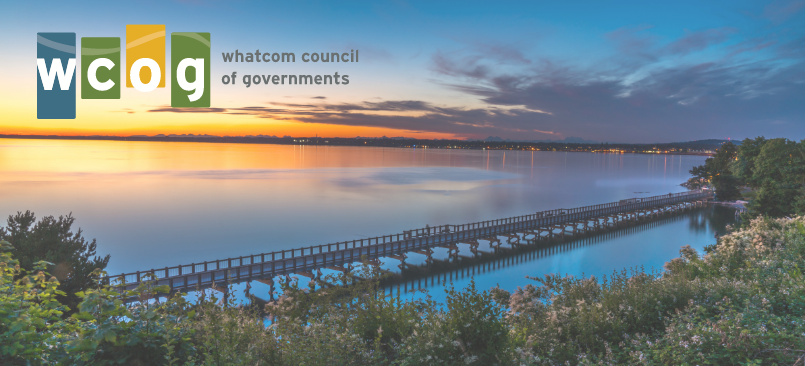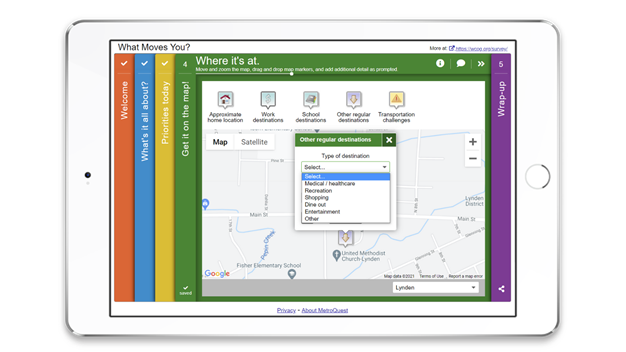An Interview with Hugh Conroy: Transitioning to Online Engagement and Promoting Public Involvement Opportunities

I recently had the privilege of virtually connecting with Hugh Conroy, the Director of Planning for the Whatcom Council of Governments (WCOG). They’re a federal and state-designated regional planning organization located in Bellingham, Washington and a new MetroQuest subscriber!
The agency has had great community engagement success with us, and I wanted to touch base with Hugh to learn more about their transition to online engagement, their remarkable MetroQuest survey and the impressive comprehensive promotional strategy they created to help achieve high levels of online engagement.
Read on for an inside scoop on my conversation with Hugh…
Can you tell me about Whatcom COG and the types of projects you’re currently working on?
We’re a small US metropolitan planning organization (MPO) serving a population of about 225,000. As the federal recognized MPO and state designated regional transportation planning organization (RTPO), we’re responsible for managing the region’s long-range transportation plan and undertake a variety of other transportation planning and programming activities.
We’re currently updating the region’s long-range transportation plan. While the last two plan updates have included public input and review opportunities, a more dedicated regional assessment of the public’s transportation investment priorities hadn’t been conducted since 2001.
“As part of the continuous planning process, we saw the need to begin the 2022 update with a higher profile effort that would allow us to take stock of how our community’s goals for transportation investments may have changed over the last 20 years.”
We used MetroQuest to launch our 2021 Whatcom Transportation Survey for this project, which gives the public an opportunity to weigh in on our region’s long-range, 20-year transportation plan.
Can you tell me about Whatcom COG’S journey from traditional public engagement strategies to online tools and tactics?
I wouldn’t say it was so much a transition as an addition to what we’ve done in the past. As a metropolitan planning organization, we have ongoing public engagement activities related to publication of plans and actions of the regional Transportation Policy Board. With our main, 20-year plan update coming up next year, we wanted to take a bigger leap into broader public engagement and looked at online tools to do so.
“I think a combination of things made it really obvious that an online platform as our primary public engagement mode would be the way to go.”
We’d already done some of that on a smaller scale using tools like Google Forms and COVID-19 definitely limited what we would do in terms of face-to-face meetings and attending community events.
The option to leverage the relative ubiquitousness of internet-connected devices pointed to an engaging online platform like MetroQuest and proved to be a great fit with our goal of hearing and recording feedback from a much wider audience than we’ve connected with in the past.
Why did the organization decide to use MetroQuest for this project? What kind of impact has the transition had?
We looked at a variety of online platforms and surveys, but knew we wanted to have a mapping component. Not only is the extra richness of the resulting mapping information attractive for our team, but I think respondents have more fun and feel find that giving input about specific geographic locations is a lot more satisfying.
The survey is still open to the public, and we’ve already engaged 1,845 participants online! This is a drastic difference between the amount of public input we collected back in 2001.
“The 2001 Whatcom Regional Transportation Summit convened roughly 120 community members, compared to our MetroQuest survey that has reached nearly 1,900 participants and still growing.”
“At the end of the survey, participants are given the option to share their email address so that we might ask them a couple of follow-up questions and notify them when the survey summary report becomes available. So far, over 600 individuals have shared an email address which, if managed carefully, could be an important resource for some ongoing public engagement.”
WCOG developed a comprehensive promotional strategy to help increase its public engagement numbers. Can you walk us through some of the promotional tactics you used?
After completing a regional household travel survey four years ago, we were familiar with the effectiveness of old-fashioned mail. We worked with a graphics professional to design a postcard and worked with a mailing service to help ensure the postcard, which was randomly mailed to 40 percent of all households, was equally distributed within the region’s local jurisdictions.

Whatcom COG What Moves You Postcard
“We generated distinct URLs to track where people were coming from and, so far, the bulk of our responses have been generated from our postcard initiative.”
We also leveraged the in-house marketing expertise of our transportation demand management program, known as Whatcom Smart Trips, to assemble a press kit for print and radio media and partner agencies to announce the survey effort through the publications and websites they manage. We used our project website and social media accounts to advertise the survey. We’re also currently working on a second press release to help drive more engagement towards the end of the survey period.
Any tips for agencies and firms looking to reach their target demographics?
On the mail carrier routes in census areas at or below the metrics we use to track low-income or ethnic minority households, we mailed a postcard to 100% of the households in those areas to help us reach a more diverse audience and hear from traditionally underrepresented groups in our community. If you’re using mail and don’t have funds to mail to every single home, I recommend a mix of randomized selection approach and targeted saturation to increase the potential for hearing from traditionally underrepresented community members.
Congratulations to Hugh and the entire team at WCOG! We’re so impressed by your community engagement efforts and look forward to seeing the survey’s final results in the coming weeks.
For more community engagement tips, check out my interview with Adrienne Heim, SFMTA’s Public Informational Officer: An Interview with Adrienne Heim: Engagement Strategies, Tips and Techniques to Help Enhance Your Public Outreach. To learn more about how to effectively promote community engagement, check out our blog: 10 Tips on How to Promote Public Participation.
